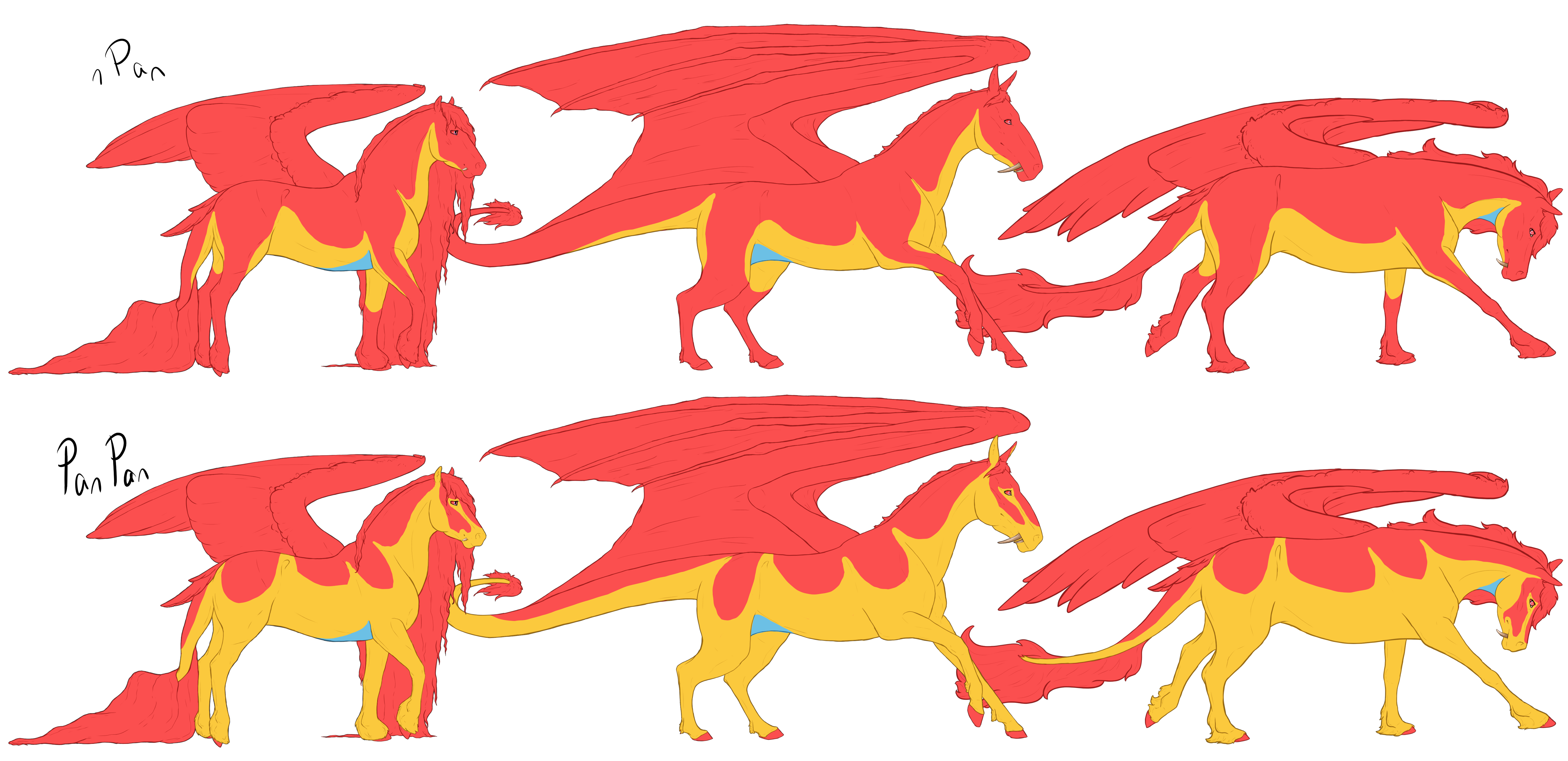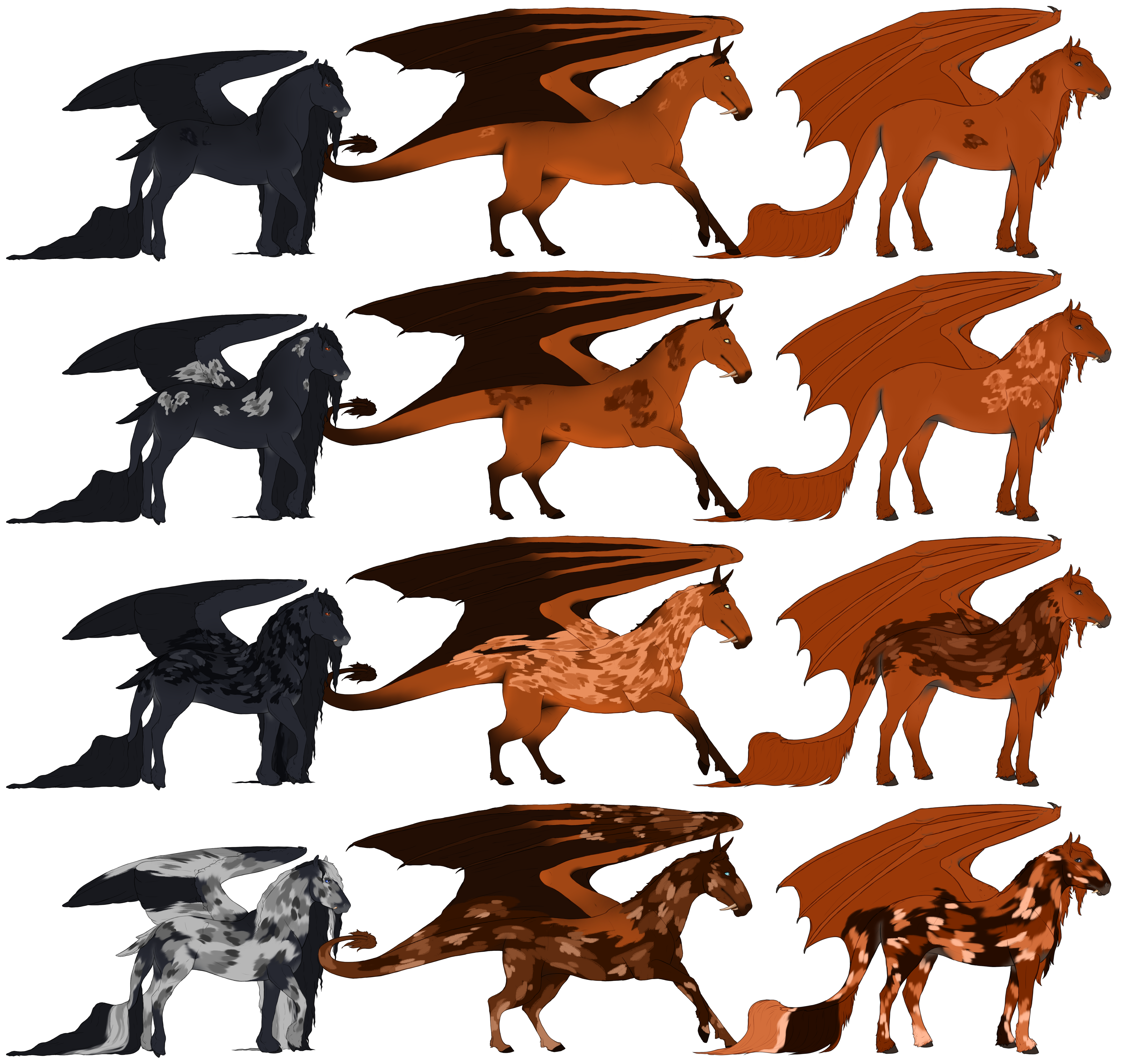Traits
Blue Breytir[Bry-b] (Rare)
nBry | Bry
Trait Count - 3
Breytir is a coat modifier that completely alters the color of the coat. It has attached modifiers that indicate it's color, red, blue, and yellow being the foundation colors.
Currently, there are three colors present in breytir, red[-r], blue[-b], and yellow[-y]. However, upon breeding and mixing the different colors, more began to pop up, primarily seen as orange[-o], green[-g], and purple[-p]. Even when breeding for these color combos, they are much more rare than the classic colors of breytir.
Breytir acts like a normal gene, so things like countershading and other gene interactions are entirely normal and will be viable. A breytir BA with single cream will have an inherently lighter coat, as dilutions will still do their job of diluting the coat.
- Flight feathers and webbing will match mane color.
- Hoof color tends to be slightly darker than the skin color.
Blue Breytir - nBry[-b] | BryBry[-b]
Silver Carrier[nZ] (Free)
Trait Count - 0
Silver carriers are only seen on Chestnut[ee] bases
Flaxen Carrier[nf] (Free)
Trait Count - 0
Flaxen carriers are one of the following;
- nf on any base
- ff on a non-Chestnut[ee] base
Orange Breytir[Bry-o] (Legendary)
nBry | Bry
Trait Count - 5
Breytir is a coat modifier that completely alters the color of the coat. It has attached modifiers that indicate it's color, red, blue, and yellow being the foundation colors.
Currently, there are three colors present in breytir, red[-r], blue[-b], and yellow[-y]. However, upon breeding and mixing the different colors, more began to pop up, primarily seen as orange[-o], green[-g], and purple[-p]. Even when breeding for these color combos, they are much more rare than the classic colors of breytir.
Breytir acts like a normal gene, so things like countershading and other gene interactions are entirely normal and will be viable. A breytir BA with single cream will have an inherently lighter coat, as dilutions will still do their job of diluting the coat.
- Flight feathers and webbing will match mane color.
- Hoof color tends to be slightly darker than the skin color.
Orange Breytir - nBry[-o] | BryBry[-o]
Green Breytir[Bry-g] (Legendary)
nBry | Bry
Trait Count - 5
Breytir is a coat modifier that completely alters the color of the coat. It has attached modifiers that indicate it's color, red, blue, and yellow being the foundation colors.
Currently, there are three colors present in breytir, red[-r], blue[-b], and yellow[-y]. However, upon breeding and mixing the different colors, more began to pop up, primarily seen as orange[-o], green[-g], and purple[-p]. Even when breeding for these color combos, they are much more rare than the classic colors of breytir.
Breytir acts like a normal gene, so things like countershading and other gene interactions are entirely normal and will be viable. A breytir BA with single cream will have an inherently lighter coat, as dilutions will still do their job of diluting the coat.
- Flight feathers and webbing will match mane color.
- Hoof color tends to be slightly darker than the skin color.
Green Breytir - nBry[-g] | BryBry[-g]
Purple Breytir[Bry-p] (Legendary)
nBry | Bry
Trait Count - 5
Breytir is a coat modifier that completely alters the color of the coat. It has attached modifiers that indicate it's color, red, blue, and yellow being the foundation colors.
Currently, there are three colors present in breytir, red[-r], blue[-b], and yellow[-y]. However, upon breeding and mixing the different colors, more began to pop up, primarily seen as orange[-o], green[-g], and purple[-p]. Even when breeding for these color combos, they are much more rare than the classic colors of breytir.
Breytir acts like a normal gene, so things like countershading and other gene interactions are entirely normal and will be viable. A breytir BA with single cream will have an inherently lighter coat, as dilutions will still do their job of diluting the coat.
- Flight feathers and webbing will match mane color.
- Hoof color tends to be slightly darker than the skin color.
Purple Breytir - nBry[-p] | BryBry[-p]
Pangare Pop[Panp] (Extremely Rare)
Pangare Pop || nPanp | PanPanp | PanpPanp
Trait Count - 4
Pangare Pop causes pangare to become more intense in color, and can even add extra shades of red and pink. On blacks, in the non-dom form it is still more subtle, but in dom form is vibrant and can even include shades of purple.
Pan Range
Blue is the minimum required expression.
Yellow is the maximum optional expression.
Red is the area expression is not allowed.
Pangare Pop Examples
Bider Mark[-b] (Rare)
-b
Trait Count - 3
Bider marks cause odd textured areas on dun horses. Bider marks will ALWAYS be textured, even in extremely dense areas.
- Skin color is unaffected by bider marks.
- Bider can be the same color or darker than the barring color
Point Range
Blue is the minimum required expression.
Yellow is the maximum optional expression.
Orange is the optional max range for DD duns.
Red is the area expression is not allowed.
Examples
Yellow Breytir[Bry-y] (Rare)
nBry | Bry
Trait Count - 3
Breytir is a coat modifier that completely alters the color of the coat. It has attached modifiers that indicate it's color, red, blue, and yellow being the foundation colors.
Currently, there are three colors present in breytir, red[-r], blue[-b], and yellow[-y]. However, upon breeding and mixing the different colors, more began to pop up, primarily seen as orange[-o], green[-g], and purple[-p]. Even when breeding for these color combos, they are much more rare than the classic colors of breytir.
Breytir acts like a normal gene, so things like countershading and other gene interactions are entirely normal and will be viable. A breytir BA with single cream will have an inherently lighter coat, as dilutions will still do their job of diluting the coat.
- Flight feathers and webbing will match mane color.
- Hoof color tends to be slightly darker than the skin color.
Yellow Breytir - nBry[-y] | BryBry[-y]
Red Breytir[Bry-r] (Rare)
nBry | Bry
Trait Count - 3
Breytir is a coat modifier that completely alters the color of the coat. It has attached modifiers that indicate it's color, red, blue, and yellow being the foundation colors.
Currently, there are three colors present in breytir, red[-r], blue[-b], and yellow[-y]. However, upon breeding and mixing the different colors, more began to pop up, primarily seen as orange[-o], green[-g], and purple[-p]. Even when breeding for these color combos, they are much more rare than the classic colors of breytir.
Breytir acts like a normal gene, so things like countershading and other gene interactions are entirely normal and will be viable. A breytir BA with single cream will have an inherently lighter coat, as dilutions will still do their job of diluting the coat.
- Flight feathers and webbing will match mane color.
- Hoof color tends to be slightly darker than the skin color.
Red Breytir - nBry[-r] | BryBry[-r]
Pangare Collar[Panc] (Rare)
Merle[Mrl] (Rare)
nMrl | MrlMrl
Trait Count - 3
Merle in BAs somewhat mimics merle in dogs, but with some exceptions. When non-dom[nMrl] it does not mess with eye color, when dom[MrlMrl] eyes will be blue or light blue in color.
nMrl will always be three colors. MrlMrl will always be four colors. Those colors will either be layer light to dark or dark to light and can be lighter or darker than the coat.
- Does not affect skin or hooves
Eye Colors
Blue, Light Blue when MrlMrl
nMrl Range
Blue is the minimum required expression.
Yellow is the maximum optional expression.
Red is the area where expression is not allowed.
MrlMrl Range
Blue is the minimum required expression.
Yellow is the maximum optional expression.
Red is the area where expression is not allowed.
Minimum Merle Expression
The top line is min, the second is med, the third is nMrl max, the last line is MrlMrl max
Grey[G] (Uncommon)
nG | GG
Trait Count - 3
Grey causes the horse to become white as they age. Compared to a normal horse, BAs grey significantly slower. Though, compared to the lifespan of a Beatus it makes sense.
- Skin and hooves are unaffected by grey.
- Flight feathers and webbing will match mane color.
- When present with white markings, grey must still be visible when next to any white.
- Dapples are almost always seen through the stages, and blood marks can start forming at any stage and become prominent towards a BAs final grey stages.
Our guide is influenced by this one over on dA.
Grey Range and Expression
Blue is the area where grey starts. Goggles and the tail are required for the most minimal expression.
Yellow is where grey will express and spread somewhat evenly across the coat.
Red is where grey affects last.
Stage 1
Age Range
Grey will always start at the head. Foals will always have grey 'goggles', these can be pretty faint when they're young. The tip of the tail will also grey early on.
Stage 2
Age Range
Early - 5- 80 years
Average - 50 - 300 years
Late - 100 - 1,000 years
Grey will progress to the inner contours of the body(flank and elbow). You can also start to see dappling at this stage.
Stage 3
Age Range
Early - 80 - 200 years
Average - 300 - 800 years
Late - 1,000 - 5,000 years
Grey will begin to progress from previous points, and dappling will be more pronounced.
Stage 4
Age Range
Early - 200 - 900 years
Average - 800 - 5,000 years
Late - 5,000 - 10,000 years
Grey will to progress further, and dappling still pronounced and visible.
Stage 5
Age Range
Early - 900 - 1,500 years
Average - 3,000 - 10,000 years
Late - 10,000 - 15,000 years
Grey will to progress further, turning the horse nearly completely white. Dapples will begin to disappear, while mane and tail may whiten. Mane and tail can still be somewhat dark at this stage. Joints will be the last area to grey out.
Stage 6
Age Range
Early - 1,500 - 3,000 years
Average - 10,000 - 15,000 years
Late - 15,000 - 20,000 years
Grey has whitened out the whole coat at this point. There may still be areas that are darker, especially around the joints.















